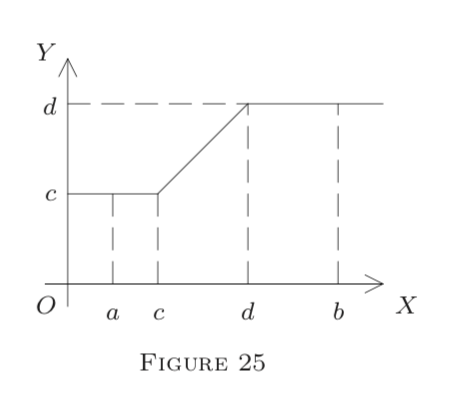5.10: Sufficient Condition of Integrability. Regulated Functions
This page is a draft and is under active development.
( \newcommand{\kernel}{\mathrm{null}\,}\)
In this section, we shall determine a large family of functions that do have antiderivatives. First, we give a general definition, valid for any range space (T,p) (not necessarily E). The domain space remains E1.
A function f:E1→(T,p) is said to be regulated on an interval I⊆E1, with endpoints a<b, iff the limits f(p−) and f(p+), other than ±∞, exist at each p∈I. However, at the endpoints a,b, if in I, we only require f(a+) and f(b−) to exist.
(a) If f is relatively continuous and finite on I, it is regulated.
(b) Every real monotone function is regulated (see Chapter 4, §5, Theorem 1).
(c) If f:E1→En(∗Cn) has bounded variation on I, it is regulated (§7, Theorem 4).
(d) The characteristic function of a set B, denoted CB, is defined by
CB(x)=1 if x∈B and CB=0 on −B.
For any interval J⊆E1,CJ is regulated on E1.
(e) A function f is called a step function on I iff I can be represented as the union, I=⋃kIk, of a sequence of disjoint intervals Ik such that f is constant and ≠±∞ on each Ik. Note that some Ik may be singletons, {p}.
If the number of the Ik is finite, we call f a simple step function.
When the range space T is E, we can give the following convenient alternative definition. If, say, f=ak≠±∞ on Ik, then
f=∑kakCIk on I,
where CIk is as in (d). Note that ∑kakCIk(x) always exists for disjoint Ik. (Why?)
Each simple step function is regulated. (Why?)
Let the functions f,g,h be real or complex (or let f,g be vector valued and h scalar valued).
If they are regulated on I, so are f±g,fh, and |f|; so also is f/h if h is bounded away from 0 on I, i.e., (∃ε>0)|h|≥ε on I.
- Proof
-
The proof, based on the usual limit properties, is left to the reader.
We shall need two lemmas. One is the famous Heine-Borel lemma.
If a closed interval A=[a,b] in E1 (or En) is covered by open sets Gi(i∈I), i.e.,
A⊆⋃i∈IGi,
then A can be covered by a finite number of these Gi.
- Proof
-
The proof was sketched in Problem 10 of Chapter 4, §6.
Note 1. This fails for nonclosed intervals A. For example, let
A=(0,1)⊆E1 and Gn=(1n,1).
Then
A=∞⋃n=1Gn( verify! ), but not A⊆m⋃n=1Gn
for any finite m. (Why?)
The lemma also fails for nonopen sets Gi. For example, cover A by singletons {x},x∈A. Then none of the {x} can be dropped!
If a function f:E1→T is regulated on I=[a,b], then f can be uniformly approximated by simple step functions on I.
That is, for any ε>0, there is a simple step function g, with ρ(f,g)≤ε on I; hence
supx∈Iρ(f(x),g(x))≤ε.
- Proof
-
By assumption, f(p−) exists for each p∈(a,b], and f(p+) exists for p∈[a,b), all finite.
Thus, given ε>0 and any p∈I, there is Gp(δ) (δ depending on p) such that ρ(f(x),r)<ε whenever r=f(p−) and x∈(p−δ,p), and ρ(f(x),s)<ε whenever s=f(p+) and x∈(p,p+δ);x∈I
We choose such a Gp(δ) for every p∈I. Then the open globes Gp=Gp(δ) cover the closed interval I=[a,b], so by Lemma 1, I is covered by a finite number of such globes, say,
I⊆n⋃k=1Gpk(δk),a∈Gp1,a≤p1<p2<⋯<pn≤b.
We now define the step function g on I as follows.
If x=pk, we put
g(x)=f(pk),k=1,2,…, n.
If x∈[a,p1), then
g(x)=f(p−1).
If x∈(p1,p1+δ1), then
g(x)=f(p+1).
More generally, if x is in G¬pk(δk) but in none of the Gpi(δi),i<k, we put
g(x)=f(p−k) if x<pk
and
g(x)=f(p+k) if x>pk.
Then by construction, ρ(f,g)<ε on each Gpk, hence on I.◻
*Note 2. If T is complete, we can say more: f is regulated on I=[a,b] iff f is uniformly approximated by simple step functions on I. (See Problem 2.)
If f:E1→E is regulated on an interval I⊆E1 and if E is complete, then ∫f exists on I, exact at every continuity point of f in I0.
In particular, all continuous maps f:E1→En(∗Cn) have exact primitives.
- Proof
-
In view of Problem 14 of §5, it suffices to consider closed intervals.
Thus let I=[a,b],a<b, in E1. Suppose first that f is the characteristic function CJ of a subinterval J⊆I with endpoints c and d (a≤c≤d≤b), so f=1 on J and f=0 on I−J. We then define F(x)=x on J,F=c on [a,c], and F=d on [d,b] (see Figure 25). Thus F is continuous (why?), and F′=f on I−{a,b,c,d} (why?). Hence F=∫f on I; i.e., characteristic functions are integrable.

Then, however, so is any simple step function
f=m∑k=1akCIk,
by repeated use of Corollary 1 in §5.
Finally, let f be any regulated function on I. Then by Lemma 2, for any εn=1n, there is a simple step function gn such that
supx∈I|gn(x)−f(x)|≤1n,n=1,2,….
As 1n→0, this implies that gn→f (uniformly) on I (see Chapter 4, §12, Theorem 1). Also, by what was proved above, the step functions gn have antiderivatives, hence so has f (Theorem 2 in §9); ; i.e., F=∫f exists on I, as claimed. Moreover, ∫f is exact at continuity points of f in I0 (Problem 10 in §5). ◻
In view of the sufficient condition expressed in Theorem 2, we can now replace the assumption "∫f exists" in our previous theorems by "f is regulated" (provided E is complete). For example, let us now review Problems 7 and 8 in §5.
Let f:E1→E (E complete) and g:E1→E1 be regulated on I=[a,b], with g≥0 on I. Then the following are true:
(i) There is a finite c∈E (called the "g-weighted mean of f on I") such that ∫bagf=c∫bag.
(ii) If f, too, is real and has the Darboux property on I, then c=f(q) for some q∈I.
- Proof
-
Indeed, as f and g are regulated, so is gf by Theorem 1. Hence by Theorem 2, ∫f and ∫gf exist on I. The rest follows as in Problems 7 and 8 of §5. ◻
Suppose f and g are real, f is monotone with f=∫f′ on I, and g is regulated on I;I=[a,b]. Then
∫bafg=f(a)∫qag+f(b)∫bqg for some q∈I.
- Proof
-
To fix ideas, let f↑; i.e., f′≥0 on I.
The formula f=∫f′ means that f is relatively continuous (hence regulated) on I and differentiable on I−Q (Q countable). As g is regulated,
∫xag=G(x)
does exist on I, so G has similar properties, with G(a)=∫aag=0.
By Theorems 1 and 2, ∫fG′=∫fg exists on I. (Why?) Hence by Corollary 5 in §5, so does ∫Gf′, and we have
∫bafg=∫bafG′=f(x)G(x)|ba−∫baGf′=f(b)G(b)−∫baGf′.
Now G has the Darboux property on I (being relatively continuous), and f′≥0. Also, ∫G and ∫Gf′ exist on I. Thus by Problems 7 and 8 in §5,
∫baGf′=G(q)∫baf′=G(q)f(x)|ba,q∈I.
Combining all, we obtain the required result (1) since
∫fg=f(b)G(b)−∫baGf′=f(b)G(b)−f(b)G(q)+f(a)G(q)=f(b)∫bqg+f(a)∫qag.◻
We conclude with an application to infinite series. Given f:E1→E, we define
∫∞af=limx→+∞∫xaf and ∫a−∞f=limx→−∞∫axf
if these integrals and limits exist.
We say that ∫∞af and ∫a−∞f converge iff they exist and are finite.
If f:E1→E1 is nonnegative and nonincreasing on I=[a,+∞), then
∫∞af converges iff ∞∑n=1f(n) does.
- Proof
-
As f↓,f is regulated, so ∫f exists on I=[a,+∞). We fix some natural k≥a and define
F(x)=∫xkf for x∈I.
By Theorem 3(iii) in §5, F↑ on I. Thus by monotonicity,
limx→+∞F(x)=limx→+∞∫xkf=∫∞kf
exists in E∗; so does ∫kaf. Since
∫xaf=∫kaf+∫xkf,
where ∫kaf is finite by definition, we have
∫∞af<+∞ iff ∫∞kf<+∞.
Similarly,
∞∑n=1f(n)<+∞ iff ∞∑n=kf(n)<+∞.
Thus we may replace "a" by "k."
Let
In=[n,n+1),n=k,k+1,…,
and define two step functions, g and h, constant on each In, by
h=f(n) and g=f(n+1) on In,n≥k.
Since f↓, we have g≤f≤h on all In, hence on J=[k,+∞). Therefore,
∫xkg≤∫xkf≤∫xkh for x∈J.
Also,
∫mkh=m−1∑n=k∫n+1nh=m−1∑n=kf(n),
since h=f(n) (constant) on [n,n+1), and so
∫n+1nh(x)dx=f(n)∫n+1n1dx=f(n)⋅x|n+1n=f(n)(n+1−n)=f(n).
Similarly,
∫mkg=m−1∑n=kf(n+1)=m∑n=k+1f(n).
Thus we obtain
m∑n=k+1f(n)=∫mkg≤∫mkf≤∫mkh=m−1∑n=kf(n),
or, letting m→∞,
∞∑n=k+1f(n)≤∫∞kf≤∞∑n=kf(n).
Hence ∫∞kf is finite iff ∑∞n=1f(n) is, and all is proved. ◻
(f) Consider the hyperharmonic series
∑1np(Problem 2 of Chapter 4, §13).
Let
f(x)=1xp,x≥1.
If p=1, then f(x)=1/x, so ∫x1f=lnx→+∞ as x→+∞. Hence ∑1/n diverges.
If p≠1, then
∫∞1f=limx→+∞∫x1f=limx→+∞x1−p1−p|x1,
so ∫∞1f converges or diverges according as p>1 or p<1, and the same applies to the series ∑1/np.
(g) Even nonregulated functions may be integrable. Such is Dirichlet's function (Example (c) in Chapter 4, §1). Explain, using the countability of the rationals.


